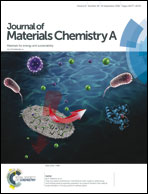CO2-philic WS2 laminated membranes with a nanoconfined ionic liquid†
Abstract
The modern global climate change and global warming of Earth make it an urgent need to develop emerging CO2 capture and storage techniques. Herein, we first reported the use of WS2 nanosheets to construct laminated membranes for CO2 separation. However, the WS2 membrane showed poor CO2 separation performance with Knudsen selectivities for N2/CO2 (1.28), CH4/CO2 (1.72) and H2/CO2 (4.96). To improve the performance, an ionic liquid (IL) 1-butyl-3-methyl imidazolium tetrafluoroborate ([BMIM][BF4]) with high CO2 solubility and practically no vapour pressure was used for filling the nanochannels of the WS2 membrane. Compared to the bulk IL, the nanoconfined IL exhibits higher freezing temperature, shift of vibration bands and higher interaction energy between CO2 and ILs. Besides, the prepared WS2 laminated membrane with the nanoconfined ionic liquid shows excellent selectivities for CO2/N2 (153.21), CO2/CH4 (68.81) and CO2/H2 (13.56) in single gas measurements as well as good CO2 permeance due to the nanoconfinement of the IL. The simulation results further confirmed and explained the CO2 separation mechanism. It indicates that the nanoconfinement of ILs into the nanochannels of two-dimensional materials is a novel way to achieve CO2-philic membranes to efficiently separate CO2 from other light gases.



 Please wait while we load your content...
Please wait while we load your content...